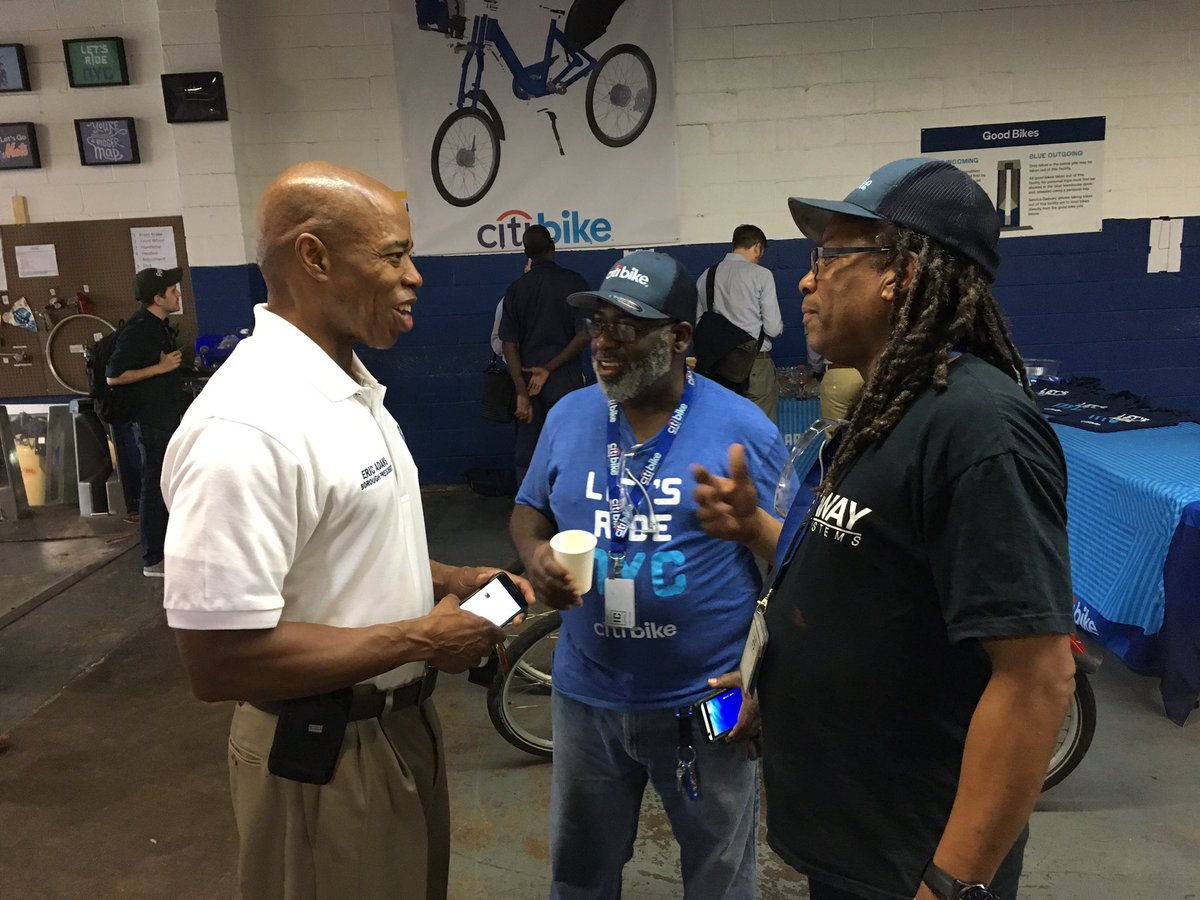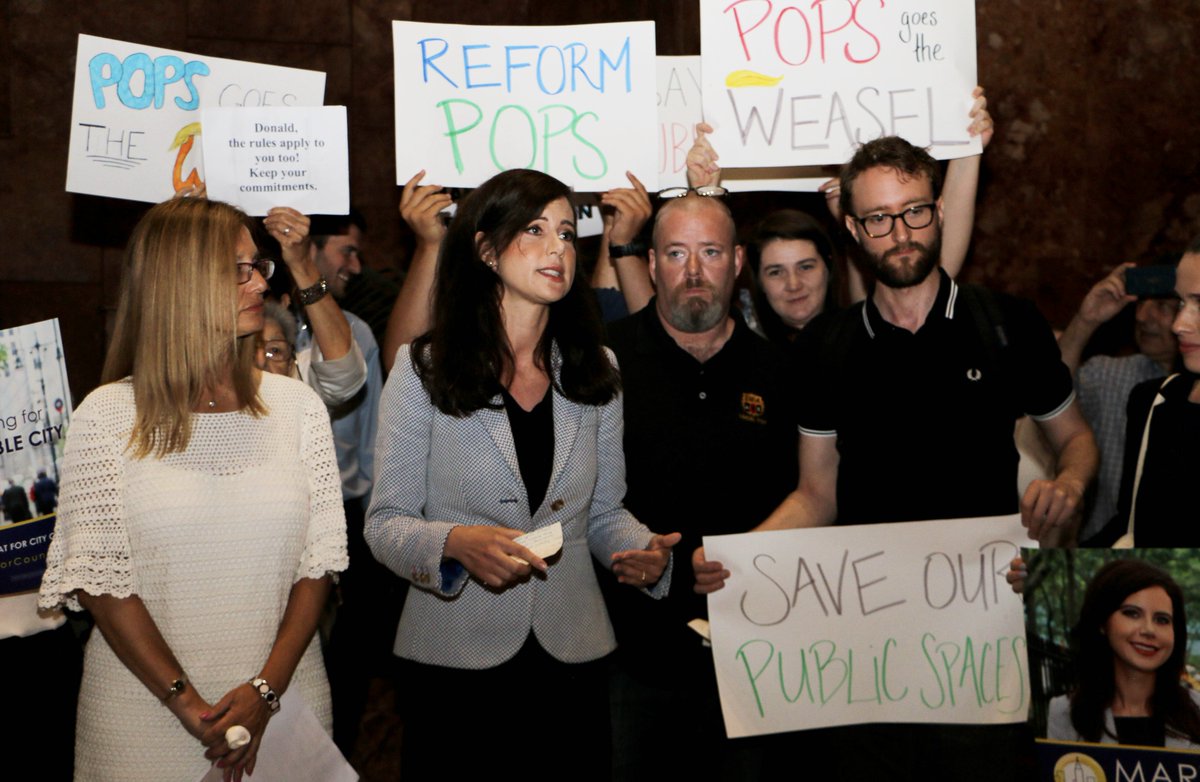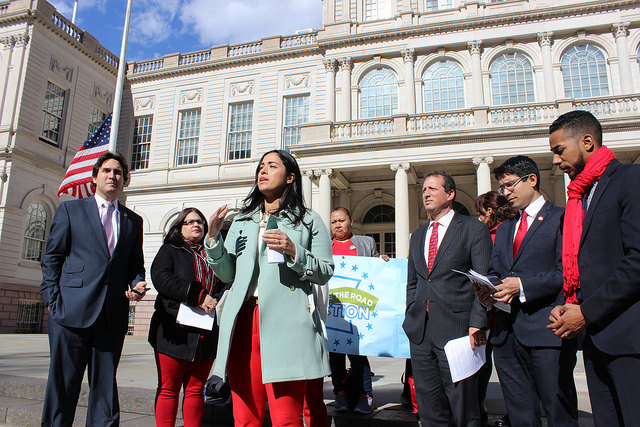Don’t Endanger Minority Jobs in Name of Construction Safety

Brooklyn Borough President Eric Adams, left, the author (photo: @BPEricAdams)
It’s good to see our city engaged in a long-overdue discussion about safety on construction sites. “Safety first” is not mere sloganeering to me; nothing should top ensuring the health and welfare of every man and woman on every worksite.
The City Council has tackled and passed a number of meaningful reforms in recent months, and there is certainly more to explore. However, New Yorkers have good reason to be concerned about a bill known as Intro. 1447, which would likely sideline many local workers of color and prevent growing minority- and women-owned business enterprises (M/WBEs) from succeeding in the construction industry.
An earlier draft of this legislation would have required apprenticeships for construction workers; the current version being considered by the Council would necessitate a training requirement well in excess of the existing federal minimum standard set by OSHA. Either of these proposals would essentially result in a union mandate. I support unions and I am a longtime union man, dating back to my 22 years of service in the NYPD. But as I have noted in the past, my union pride also carries with it a responsibility to speak out when I believe there is inequity of opportunity within the ranks of my brothers and sisters in labor. In the construction industry, this largely remains the case, with several exceptions such as Carpenters Local 926.
The reality is that while some important gains have been made, I see from my own experience that union construction sites continue to fall short in reflecting the diversity of New York City. Equally important, too many of the union workers on Brooklyn’s construction sites do not actually live in our borough, or any of the five boroughs.
While construction unions have promoted apprenticeships and additional skills training as both a path to safer worksites and a way to diversify their workforce, no independent data has been released that shows the linkages for these claims. There is still no evidence that these efforts are providing minority workers with a reliable road to long-term career advancement. While apprenticeship programs may become more diverse, the higher-paying jobs on actual union worksites still elude the minority workforce. Until that changes, we should remain wary of approving de facto union mandates on construction sites that could otherwise provide much-needed job opportunities for highly-qualified New Yorkers of color, especially those living in public housing seeking a path to the middle class.
When it comes to M/WBE contractors, Intro. 1447 would have a very damaging impact because of the extremely high cost of its arbitrary training mandate. As City Council members should know, M/WBEs in the construction industry are generally smaller and less established than their competitors. If costs were to skyrocket, many M/WBEs would likely be unable to afford the difference, making it virtually impossible to compete for the jobs they need to stay in business. We must avoid any outcome that bars these hardworking small business owners from getting a fair shot in our city.
There is a strong argument that a universal enforcement of OSHA training certification requirements would be just as effective, and in some cases more so. We have seen that projects following strict standards on OSHA training — whether they be union or non-union — maintain safer sites and have fewer injuries. This would be a substantive step forward for safety.
I have sought to reframe the union construction conversation around the idea of job creation for all. It is only worth fighting for higher construction wages and good jobs when we ensure that all workers, including those who continue to fall through the inequality gap, are sharing equally in those victories. Now we also need to do the same thing for construction safety. There is no question that we need to make worksites safer, but it must be safer for all workers — and that means we must have an industry in which workers of all backgrounds have equal opportunity to participate and prosper.
***
Eric L. Adams is the Brooklyn borough president. On Twitter @BPEricAdams.
***
Have an op-ed idea or submission for Gotham Gazette? Email This email address is being protected from spambots. You need JavaScript enabled to view it.
Life-Saving Legislation That Must Not Wait

Marti Speranza, the author, center (photo: @MartiSperanzaNY)
The passage of the East Midtown Rezoning will lead to the construction of an estimated 16 buildings, six Subway projects, and many public spaces over the next 20 years. The plan utilizes density bonuses to incentivize developers to pay for transportation and public realm upgrades, while also empowering cash-strapped landmarks to capitalize on their air rights. All the stakeholders made compromises to reach the final deal, which will begin an era of restoring East Midtown to a globally competitive business district.
One thing that can’t be compromised is the safety of the workers, neighbors, and future occupants of East Midtown––or any neighborhood in our city.
In order to address the increase in construction deaths during the construction boom across our city, the City Council has introduced life-saving legislation to make work safer for the 180,000 construction workers who build and live here. Intro. 1447, which would mandate additional safety training, has the support of 46 Council sponsors. These legislators recognize that more safety training is needed to prevent avoidable accidents. As major projects like the Hudson Yards and the East Midtown Rezoning progress, this legislation becomes even more important.
The Real Estate Board of New York (REBNY) is one of the biggest opponents of the bill. It claims it will shut smaller, non-union M/WBE contractors out of lucrative construction deals while rewarding union shops, whose record of worksite safety has been better due to the hours of union-provided safety training and other precautions. Masquerading as a nonprofit called “Putting New Yorkers to Work,” REBNY has run ads against the bill, featuring construction workers of color making appeals to the City Council to not “take their jobs away.”
The reality is that workers of color, specifically Latino workers, could have the most to gain from this legislation. They have been disproportionately killed in construction accidents, the overwhelming majority of which have occurred on non-union worksites, according to a New York Committee for Occupational Safety & Health report released earlier this year.
The possibility of decreasing opportunities for M/WBEs is a serious concern that needs to be addressed. But to frame this bill as a choice between opportunities for M/WBE contractors and safety of workers is disingenuous. It’s cynical to imply this legislation is designed to penalize open-shop contractors. There’s no room for error on worksites; safety trainings -- union-sponsored or otherwise -- prepare workers to handle the inherent dangers of construction work and mitigate risks. The aim of Intro. 1447 has always been to increase safety on worksites -- that should be a top priority for all.
The final version of the legislation should not yield to demands for fewer hours of safety training. If opponents’ chief concern is the potential to undermine opportunities for M/WBEs in construction, legislators should move quickly to study the impact it could have on M/WBEs and ensure those firms have a voice in the conversation.
The battle over Intro. 1447 is an example of politics getting in the way of policy. That’s something we can’t allow to happen when lives are in the balance.
***
Marti Speranza is a Democratic candidate for City Council in District 4. On Twitter @MartiSperanzaNY.
***
Have an op-ed idea or submission for Gotham Gazette? Email This email address is being protected from spambots. You need JavaScript enabled to view it.
‘Fair Share’ Reform – An Essential Step to Solving the City’s Homelessness Crisis

Carlina Rivera, the author (photo: Samar Khurshid/Gotham Gazette)
Repairing the subways, closing Rikers, rescuing failing schools – it can seem like New York’s most insurmountable crises are always being dealt with by cutting corners and taking the path of least resistance. This isn’t how it’s always been in our city. When the city passed the historic Fair Share Criteria in 1989, officials finally said enough to the inequitable distribution of city facilities and called for investment in a long-term plan for facility siting in the future.
These rules were supposed to require the city to place facilities in a thought-out, deliberative process that factored in their potential effectiveness as well as the input of the community. Unfortunately that hasn’t been the case.
Over the years, the original Fair Share Criteria have been found to be non-transparent and filled with loopholes that city officials and agencies continue to exploit to this day, particularly when it comes to homeless shelter siting.
The city’s new homelessness plan shows this disregard for Fair Share, with officials looking to place shelters in the easiest-to-build locations in order to satisfy the plan's goal of building 90 new shelters. Sadly, this means that overburdened communities are once again seeing shelters open just blocks away from existing shelters, while nearby neighborhoods continue with few or no shelters at all. This is a clear misallocation of resources that will only help to exacerbate difficulties around existing shelters.
Want a real example of how Fair Share isn’t being factored into the city’s homelessness response? One of the newest facilities in the city, a 28-unit shelter that is set to open soon in on East 17th Street in Gramercy, perfectly illustrates the current situation. This shelter is exactly what the city needs – its small size will create a safer, more comfortable environment for its residents, and the facility will have access to the programs that can get New Yorkers back on their feet.
But this shelter’s innovations quickly end when it comes to its location. The site was quietly chosen largely because it was a former treatment center and easy to develop, even though the community already has nearly 1000 beds within walking distance at the 30th Street Men’s Shelter. With such a large population and a lack of individualized supportive services, this shelter has been a disappointment for many who reside in it and a continued complaint of local residents who see hundreds of men outside each day with seemingly no path to housing stability.
I want our district to be a role model for the rest of the city, where we each accept the same, equal responsibility to help. When I am elected to the City Council, passing the recently announced Fair Share reform package will be one of my first legislative goals.
I also understand that new shelters such as the one on 17th Street will be a real resource for our community’s most vulnerable residents. However, we also must be fair and recognize the terrible situation occurring at large, less-effective shelters such as 30th Street, and couple any new shelter openings with a reduction of beds at larger or failing shelters. This would bring shelters like 30th Street more in line with the smarter, smaller shelters we need in this city.
For years the city favored quick fixes over a long-term solution to homelessness. But homelessness has never been an issue that can just be swept under the rug and forgot about, or dealt with by warehousing people. It requires a forward-thinking strategy that looks at each level of the homelessness support structure and honestly asks if we can do better.
A better Fair Share is the first step in this process, and it won’t be easy. But our city’s biggest accomplishments have always emerged from the most visionary ideas. We know what needs to be done – now we just need the courage to follow through with it.
***
Carlina Rivera is a candidate for New York City Council’s District 2, which covers the East Village, Gramercy Park, Kips Bay, Flatiron, Lower East Side, Murray Hill, Rose Hill. On Twitter @CarlinaRivera.
***
Have an op-ed idea or submission for Gotham Gazette? Email This email address is being protected from spambots. You need JavaScript enabled to view it.




